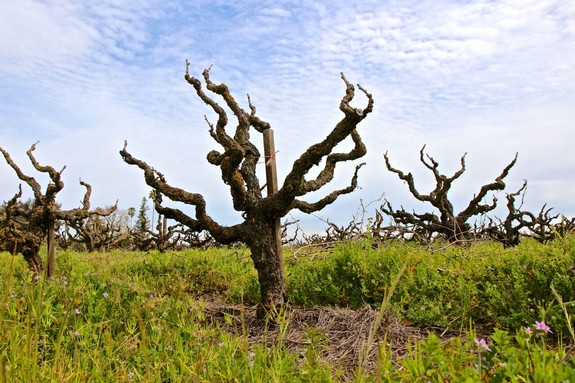A while back I posted on head-training grape vines. Last week I received a comment from Laura, who writes:
Sorry I’m very late making this comment, but I somehow missed this post when you made it. I found a site with a description, pros and cons, and some color photos of head-training grapevines. I thought you might want to look at it:
https://www.lodigrowers.com/optimizing-head-trained-vineyards/
I think I will try this the next time I plant grapevines; it definitely looks like a superior training method for grapes planted in a Grocery Row Garden.
Thank you, Laura. There is a wealth of information there.
As Stan Grant at Lodi Growers states:
“It is important to distinguish between the goblet form of head training and vertical cordons, which some in our industry mistakenly call head training (Fig. 2). Vertical cordons are simply trunks trained vertically onto a tall stake with arms and spurs located at intervals along their length. While vertical cordon training is more expeditious and less labor intensive than gobelet training, it has a major inherent disadvantage. Grapevines display the apical dominance phenomena, in which organs, such as shoots, at higher positions acquire a greater share of vine resources at the expense of organs at lower positions. Consequently, shoots at higher positions on vertical cordons grow and develop more rapidly than those at lower positions. Apical dominance on vertical cordons also creates a fruit yield and ripening gradient. Because grapevines are woody perennial plants, apical dominance effects accumulate and the differences between higher and lower positions on vertical cordons become greater over time. Obviously, vertical cordons are less conducive to consistent production of high quality winegrapes than goblets.”
There are some photos on the Lodi Growers site in the article you’ll find interesting. It’s very different from how we normally see grape vines growing, and is more in line with Backyard Orchard Culture than with traditional viticulture wire training.
The method is fascinating and economic in its use of materials. As Grant continues:
“Trunks and heads require stakes for tying and support until the truck reaches 4 or 5 inches in diameter. Typically, 5 foot long stakes are installed with about 2 feet in the ground. Greater consistency in vine form, enhanced canopy stability, and increased ease of vineyard operations offset the cost of stakes.
After topping to establish a head, allow lateral shoots near the top of the trunk to grow to initiate arms. While trunk topping can take place at any time, arm training is usually limited to dormant canes during winter pruning. During the first year, retain long spurs that radiate outwards at the head (≈ top 10 to 15 inches) of the trunk and that are spaced as evenly as possible around the trunk like spokes of a wheel. Long spurs, in this instance, have 3 to 4 nodes or buds each. Spurs with more nodes are not sufficiently rigid to support the weight of shoots the following growing season. Commonly, 3 spurs are left the first year, but some growers may keep more to promote earlier production. Growth vigor is concentrated into one or two shoots at the end of the spurs by shoot thinning early in the growing season.
A year or two after they are initiated, arms are divided and extended into two or more branching arms. As before, ensure the new branches are as evenly spaced as possible. Also at this time, begin to direct the arms upward as well as outward.
After several years of conscientious training, goblets with a diameter of 24 to 30 inches and about 7 to 9 evenly spaced spur positions are the result. From this point, maintenance of the goblet is the goal and for this reason, canes are typically pruned to 1-node spurs during each winter. Periodically, to maintain the goblet size and shape, a spur arising from old wood on the arm below the current spur position is retained at pruning and the portion of the arm beyond is removed.”
It takes some skill and forward thinking, but it’s a great idea. Eventually, you don’t need stakes or wires.
I’ll have to try it with at least one of my muscadines. We can’t grow the varieties they are using there in California, so we’ll have to see if the crazy growth of muscadines could be similarly restrained and trained.
I could also see it working well in a Grocery Row Garden or small backyard space.
*Image at top via LodiWine.com (they have some great articles – you need to check out the site)


5 comments
Good idea. The technique reminds me of an old wisteria vine I used to sit under as a child that was trained to grow like a small tree.
Very interesting, I may give this a try.
Hey Dave I wanted to ask did you having any experience with high density fruit tree planting and if so could you possibly do a bit on it since you’ve been gardening for a while when you have the time. Were moving back to Houston after a year and have two city lots we live and garden on and I’m trying to get some more info on tree hedges, high density planting etc. Thanks again and have a blessed one
Fascinating! I wonder if I could figure it out without killing my grapes I love the concept!
Awesome, thank you Laura and David. After the first article my son and I “converted ” our muscadines when pruning this winter( about 8 vines) on 25 acres we own away from the city we live in, also did the same to a Southern Home grape vine here at our house so I’m excited to read this and learn more! Nathan
Comments are closed.